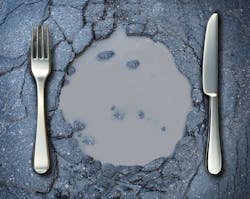Hunger attack: As we celebrate dental hygiene, other organizations target hunger
By JoAnn Gurenlian, RDH, PhD
It is National Dental Hygiene Month, a time to celebrate the many things we do as oral health professionals to prevent disease and promote health. October is busy with activities to help the public and stakeholders better understand who we are and what we do. Like you, I am proud of the many community programs we provide during this month and throughout the year to support the profession and the health of the public. So many of us contribute to worthy causes, such as women’s shelters, backpack programs, cancer organizations, etc.
As we prepare for the many events to celebrate dental hygiene this month, there is another monthly observation we may want to address: Tackling Hunger Month. According to a 2015 report from the United States Department of Agriculture, 42.2 million people live in food insecure homes, and 6.3 million of these households had what is termed “very low food security” at some time during 2015.1 Food insecurity is a term used by the USDA to mean an inability to afford enough food for all household members at times.2 Families with children have significantly higher rates of food insecurity than homes without children.2 The people affected are often hard-working adults, seniors, and families who simply cannot make ends meet and are forced to go without food for several meals or sometimes for days.
I know many of us have been busy and worked through lunch. We’ve gone home at dinnertime and exclaimed, “I’m starving.” I wonder if we really understood what those words meant.
We have to be grateful if we have never had to choose between paying the electric bill and buying groceries. According to Feeding America, over 65% of food insecure people reported they had to choose between food and utilities, food and transportation, and food and medical care.3 Others had to choose between food and housing or food and education.3 Coping mechanisms include purchasing inexpensive, unhealthy food and receiving help from family and friends.3 To a lesser extent, some choose to water down food and drinks, sell personal property, or grow their own food.3
The consequences of hunger include chronic diseases such as diabetes, hypertension, and cardiovascular disease.4 Children are affected with delayed development, higher risk of asthma and anemia, and behavioral problems such as hyperactivity, anxiety, and aggression.5
We can help tackle hunger by supporting mobile pantry programs, summer child nutrition programs, the Feeding America BackPack program, Kids Cafe programs, Senior Grocery programs, and the Supplemental Nutrition Assistance Program (SNAP). These programs offer nutrition assistance throughout the nation through various organizations, including schools, Boys & Girls Clubs, YMCA branches, senior centers, and farmers’ markets. Our local component and state organizations can partner with these groups to help communities reduce hunger and improve oral health.
Perhaps your organizations have already determined which groups to work with this season, which, of course, is wonderful. Just consider for the future that millions need help, and certain states have significantly higher food insecurity rates than the national average. According to DoSomething.org, these states include Arkansas, Mississippi, Texas, Tennessee, North Carolina, Missouri, Georgia, and Ohio.2 Lastly - and sadly - approximately 40% of food is thrown out in our country each year.2 This food could feed half of those who are hungry.2
We can do better. Maybe we should try. I have never known anything better than the power of dental hygienists. For more information, visit feedingamerica.org, dosomething.org, and HungerFight.org. RDH
JOANN R. GURENLIAN, RDH, PhD, is president of Gurenlian & Associates, and provides consulting services and continuing education programs to health-care providers. She is a professor and dental hygiene graduate program director at Idaho State University, and past president of the International Federation of Dental Hygienists.
References
1. Food Security in the U.S.: Key Statistics and Graphics. United States Department of Agriculture Economic Research Service website. http://www.ers.usda.gov/topics/food-nutrition-assistance/food-security-in-the-us/key-statistics-graphics.aspx. Updated October 11, 2016. Accessed August 23, 2017.
2. 11 facts about hunger in the US. DoSomething.org website. http://www.dosomething.org/facts/11-facts-about-hunger-us. Accessed August 23, 2017.
3. Impact of Hunger. Feeding America website. http://www.feedingamerica.org/hunger-in-america/impact-of-hunger. Accessed August 23, 2017.
4. Importance of Nutrition on Health in America. Feeding America website. http://www.feedingamerica.org/hunger-in-america/impact-of-hunger/hunger-and-nutrition. Accessed August 23, 2017.
5. Child Hunger Fact Sheet. Feeding America website. http://www.feedingamerica.org/assets/pdfs/fact-sheets/child-hunger-fact-sheet.pdf. Published March 2017. Accessed August 23, 2017.

